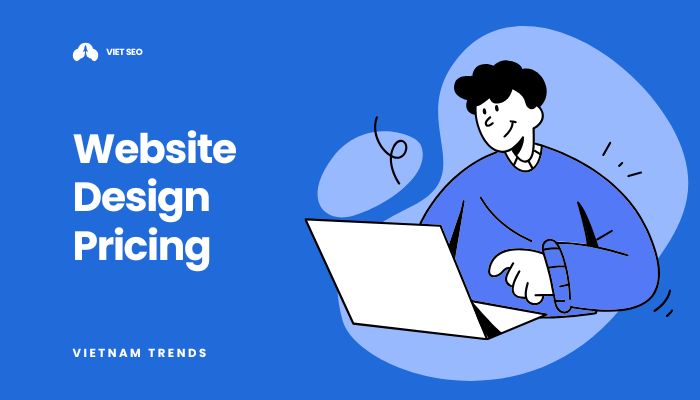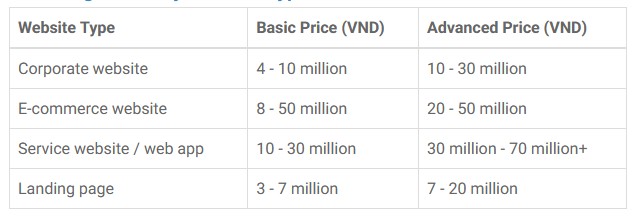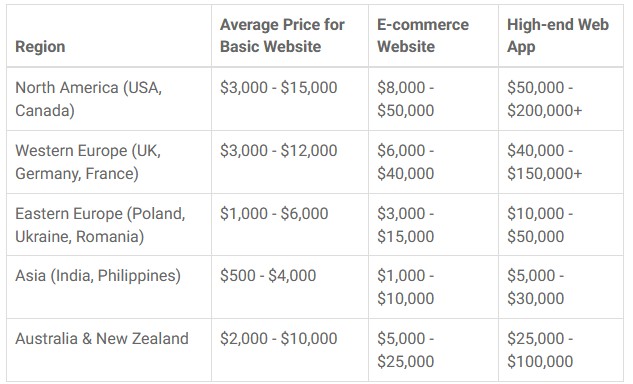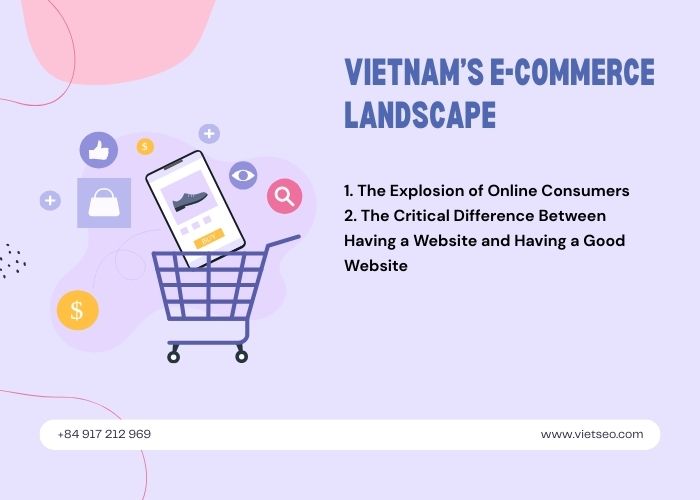Website Design Pricing Trends: Vietnam vs. Global Market
The website has become the face of a business, an online store, a brand promotion tool, a primary sales channel, and sometimes even the core product platform. One question that always arises when a business, organization, or individual wants to build a website is: "How much does it cost to design a website?"
There is no simple answer to this question. Website design prices vary greatly depending on a multitude of factors: features, quality, technology used, experience of the design team, included services, and of course, geographical location.
This article will delve into the cost of website design in Vietnam compared to international markets, giving you a comprehensive view while updating the latest global pricing trends. Most importantly, we will share new ideas on how to optimize costs without compromising quality — a smarter approach than traditional cost-cutting methods.
Factors That Influence Website Design Costs
Before comparing prices, it’s important to understand the key factors that drive website design costs. Without this context, it’s easy to make unfair comparisons or choose the wrong solution for your needs.
1. Purpose and Type of Website
The type of website you want to build directly affects both complexity and cost:
- Corporate website: Usually simpler, with fewer pages, mainly for company profiles or basic information. These tend to be the most affordable.
- E-commerce website: Needs product catalogs, shopping carts, order tracking, and payment gateways—naturally costing more.
- Service website or web application: Often requires custom features, user accounts, and complex logic, so it falls on the higher end of the pricing scale.
- Marketing landing page: Focused on lead generation or conversions. It may look simple but often requires advanced marketing tactics and A/B testing.
2. UI/UX Design Quality
A well-designed user interface (UI) and smooth user experience (UX) can make or break your website:
- Templates vs. custom design: A ready-made template is cheaper but less unique. A fully custom design ensures branding consistency and better usability but costs more.
- UX focus: Modern businesses invest in UX research, wireframes, and usability testing—these steps add value but also increase overall costs.
3. Technology Stack
The tools and platforms behind your website play a big role in pricing:
- CMS platforms (WordPress, Joomla, Drupal): These help reduce costs by providing ready-made functionality.
- Custom development: For tailored performance, scalability, and security, custom coding comes at a higher price point.
- Modern frameworks (React, Angular, Vue.js): Essential for highly interactive or app-like experiences, often requiring bigger budgets.
4. Features and Integrations
The more functionality you need, the higher the cost:
- Advanced integrations: CRM, ERP, payment gateways, AI chatbots, or analytics tools all add layers of complexity.
- Extra capabilities: Multilingual support, SEO optimization, or mobile-first design standards require additional investment but pay off in user experience and reach.
5. The Team Behind the Project
Who you hire to build your website makes a huge difference:
- Freelancers: Usually cheaper but carry risks in reliability and support.
- Local web design agencies: Offer a balance between cost, quality, and after-sales support.
- International agencies or big companies: Higher costs but come with strong processes, diverse expertise, and enterprise-grade quality.
Website Design Pricing in Vietnam - 2025 Market Overview
Vietnam's website design market has grown rapidly over the past five years. Prices have also seen significant changes.
1. Average Price by Website Type
2. Characteristics of the Vietnamese Market
- Highly competitive, very diverse pricing.
- Many freelancers offer low-cost services under 5 million VND, but quality is inconsistent.
- Professional design companies account for about 30% of the market, usually offering standard packages and post-sales support.
- The trend of combining website design with digital marketing services is becoming increasingly popular.
3. Advantages of Website Design in Vietnam
- Labor costs are lower compared to international markets.
- Flexible service approach; can handle small-scale projects.
- Strong "meet the deadline" service culture.
- Easy communication, fewer language barriers.
4. Disadvantages
- Some providers lack standardized processes.
- Insufficient investment in advanced user experience (UX).
- Limitations in adopting the latest technologies.
International Website Design Pricing — Global Overview
1. Average Price by Region
2. Advantages of International Markets
- Professional, rigorous processes.
- Experienced teams, up-to-date with the latest technologies.
- High-end UX/UI services delivering superior user experience.
3. Disadvantages
- High costs, especially in North America and Western Europe.
- Time zone and language barriers when outsourcing internationally.
- Requires remote quality control, which can take additional time.
Comparing Website Design Pricing: Vietnam vs. International
1. Cost Comparison
- Vietnam is 2-5 times cheaper than US and European markets.
- Compared to Eastern Europe and India, Vietnam currently offers comparable prices or is slightly higher but has an advantage in customer service.
2. Quality Comparison
- For basic websites, Vietnam’s quality fully competes with international standards.
- For complex websites (web apps, large platforms), Vietnam still needs to improve UX/UI design and project management according to Agile/Lean standards.
3. When to Choose Local Design vs. Outsourcing Internationally
Choose local when:
- The project requires fast communication and direct collaboration.
- You need to optimize costs while maintaining good quality.
- The project requires frequent updates after completion.
Choose international outsourcing when:
- The project has a good budget and requires high-end user experience.
- The website is the core product platform (tech startup, SaaS).
- You need international scalability and integration with large systems.
New Trends in Website Design Pricing
Website design pricing has changed a lot in recent years. Instead of sticking to the old “pay once, get a website” approach, many agencies are adopting new models that reflect the real value and evolving needs of businesses. Here are some of the latest trends:
1. Flexible, Value-Based Pricing
Rather than charging based on hours worked or project size, many companies now look at the value the website delivers.
- For example, if an e-commerce site brings in 1 billion VND in revenue, its design cost might be 100–200 million VND instead of the usual flat 50 million VND under the old pricing model.
- The idea is simple: businesses pay according to the return on investment (ROI), not just the designer’s time.
2. Subscription Model – Website as a Service
Instead of paying a large one-time fee, businesses can now subscribe to Website-as-a-Service (WaaS) plans:
- Pay a monthly fee (from 500,000 VND to several million VND) for continuous updates, hosting, and support.
- Perfect for startups or small businesses with limited upfront budgets.
- Advantage: Your website is always up to date with the latest technology, so you never have to worry about it becoming outdated.
3. Lifetime Service + Marketing Bundles
Some agencies now offer all-in-one packages that include:
- Website design
- SEO optimization
- Online advertising campaigns
- Ongoing website management
While the initial cost is higher, businesses benefit from a complete growth solution rather than just a static website. This model focuses on business results instead of simply delivering a “nice-looking” site.
4. AI-Powered Websites
The integration of AI technology into website design is another growing trend:
- AI can personalize user experiences, automate content updates, or provide smart analytics for marketing campaigns.
- These sites can cost 20–50% more than traditional ones, but they offer smarter automation and higher engagement, which often leads to better ROI.
New Ideas to Optimize Website Design Costs
A quality website doesn’t always have to come with a huge price tag. With smart planning and the right approach, you can create a professional, high-performing website without overspending. Here are some practical ideas to help you manage your budget effectively while still ensuring a great user experience and solid business results:
1. Start with the MVP (Minimum Viable Product) Approach
Instead of going all-in with a massive upfront investment, build the simplest functional version of your website first:
- This allows you to test real user feedback early on.
- You can add features gradually based on what works best.
- It reduces risks and helps keep initial costs under control while ensuring flexibility for future improvements.
2. Combine Premium Templates with Smart Customization
You don’t always need a 100% custom design. A high-quality template plus tailored UX elements can:
- Cut costs by up to 50% compared to fully custom development.
- Still give you a unique brand look with a much faster turnaround time.
This approach is perfect for startups or small businesses aiming for professional yet affordable solutions.
3. Work with a Small, Skilled Team
Instead of hiring a large agency with high overhead costs, consider a lean team of 2–3 experts:
- A UX designer for user experience.
- A developer for coding and technical setup.
- A project manager to keep everything on track.
Smaller teams often bring more flexibility, better communication, and lower costs while maintaining quality.
4. Focus on Content Instead of Overly Complex Design
A website with clear messaging, compelling content, and solid SEO will outperform a fancy but empty site:
- Invest in content strategy early, including blogs, landing pages, and product descriptions.
- Use design to support the message rather than overshadow it.
Remember, visitors come for information and solutions—not just flashy graphics.
Conclusion
Website design pricing is not a fixed number — it results from dozens of influencing factors. Vietnam’s market is increasingly matching international quality in the basic website and e-commerce segments.
However, businesses must be mindful when choosing partners, focusing on the value received rather than just the cheapest price.
Emerging trends like value-based pricing, subscription websites, lifetime service packages, and AI-driven websites will continue to reshape website pricing models in the coming years.
Finally, remember: the cost of website design matters less than the business outcomes your website delivers. Smart investment today will save you more in the long run.





